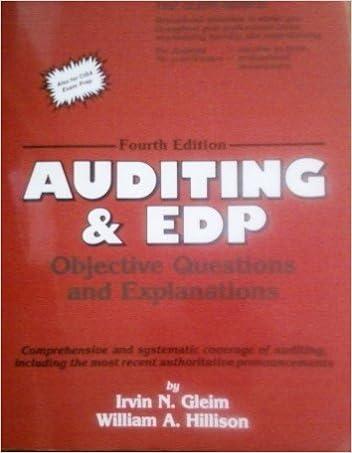Question
Problem Set 5 Problem 1 Annuity and Perpetuity a) Derive PV formula for a perpetuity with payment x and interest equal to r b) Derive
Problem Set 5
Problem 1 Annuity and Perpetuity
a) Derive PV formula for a perpetuity with payment x and interest equal to r
b) Derive PV formula for annuity with payment x, maturity T, interest rate r. . . . . . . . . .
. . . . . . . . .
Problem 2 Present Value, use a calculator
a) Buying or renting: You are moving in to Madison (you are going to stay here forever!) and you would like to find an apartment. You can either buy it or rent it. The monthly rent is $500 and the monthly interest rate is 0.1%. Alternatively, you can purchase the apartment, paying $600, 000: How are you going to finance your new accommodation? Argue using the P V formula.
b) You take a loan to buy a car that costs $4000. What is your monthly payment if you want to pay back the loan after 3 years, (36 payments) and the monthly interest rate is 0.5%: (Hint: Loan with constant payments is like annuity!)
c) You want to receive $40, 000 per year when retired (61 and 80). How much do you have to save between 21-60 years. (Interest rate is 5%)
d) You save $20, 000 per year when working (21 and 60). How much will you consume per year when you retire (age 6180) (Interest rate is 5%)
. . . . . . . . .
Problem 3 Life cycle problems (can use Excel program)
a) You are going to earn t = $200, 000 when working (age 21 and 60), and then you are going to live for the next 20 years with t = $0. Find the constant level of consumption C during years (21-80) that can be financed by your income (Interest rate is 5%). Find the level of savings St = t C for periods t 60 and for t > 60
b) Consider the problem in a). Assume that you inherit $1, 000, 000 (one million $) apart from your regular income, at the age of 20. Find C and St?
c) Consider the problem in b). Assume that you also leave your offspring a bequest of $1, 000, 000 (one million $). Find C and St .
d) Optional: Accumulated wealth in period is given by Wt = Wt1(1+r)+St that is it coincides with wealth from the previous period plus interest and savings in t. The agents initial wealth is W20 = 0. Using Excel sheet, plot the behavior of wealth Wt over your life time for points a-c. When the agents wealth attains its maximum? What can you say about the wealth level at the end of life: W80?
. . . . . . . . .
Problem 4 Insurance
Ben is a proud owner of a romantic mansion facing the lake Mendota worth $500, 000. The location attractive as it is, however has one drawback. Occasionally in the spring heavy rains raise the water level in the lake, flooding the house. When this happens, the value of the house drops to $50, 000. The flood occurs with probability 1/10. Ben finds the situation too stressful and therefore he is going to sell the house in the summer (after the potential flood). By cF and cNF denote his wealth when there is, and there is no flood respectively.
a) In the commodity space (cF , cNF ) show the affordable bundle if there is no insurance (the endowment point).
b) Ben can buy insurance that pays x dollars when there is a food, paying premium 0.1x (for given premium rate = 0.1 he can choose any x.) - find analytically and show on the graph his budget constraint.
c) Suppose Bens Von Neumann Morgenstern expected utility function is given by U(CF , CNF ) = 0.1(CF) + 0.9(CNF) . Is Ben risk averse (argue using a graph of his Bernoulli utility function)?
d) What is his MRS at the endowment point (no insurance)?
e) Find the optimal insurance and wealth levels under two contingencies. Does he insure fully?
f) On the graph show how your answer changes if the insurance premium is 0.2x (that is insurance premium rate is = 0.2) . . . . .
. . . . . . . . .
Problem 5 Risk aversion
Frank McGambler needs our advice. He is thinking about a lottery ticket that gives $100 with probability (1/2) and zero otherwise (also with probability (1/2)).
a) Plot the Bernoulli utility function, given by u(c) = c on a graph. Is Frank risk averse?
b) What is the expected value of the lottery? (give the number and mark it on the graph).
c) What is the expected utility from the lottery? (give a number and mark it on the graph).
e) Which one should Frank chose to maximize his utility ? Expected value of the lottery for sure or the lottery itself? Is he risk averse, risk loving or risk neutral?
f) Give answers to questions b-e, assuming Bernoulli utility function is u(c) = c
g) Give answers to questions b-e, assuming Bernoulli utility function is u(c) = c^2
Step by Step Solution
There are 3 Steps involved in it
Step: 1

Get Instant Access to Expert-Tailored Solutions
See step-by-step solutions with expert insights and AI powered tools for academic success
Step: 2

Step: 3

Ace Your Homework with AI
Get the answers you need in no time with our AI-driven, step-by-step assistance
Get Started


